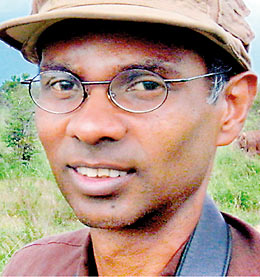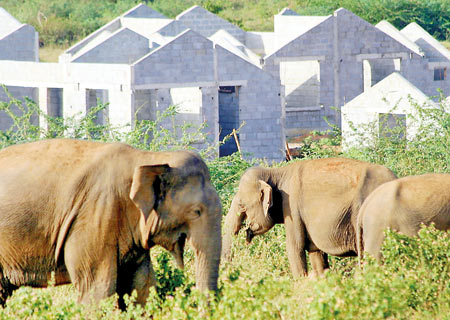News
Solution to man-beast conflict lies with stakeholders:Top researcher
With the new Government’s manifesto promising a solution to the human elephant conflict, the new Wildlife Minister Gamini Jayawickrema Perera says he will treat it as a priority, calling for a report by Tuesday.

Dr. Prithiviraj Fernando
Many blame Wildlife Officers for not providing a viable solution to the problem. However, the Department of Wildlife Conservation (DWC) alone cannot provide a solution, points out Sri Lanka’s foremost elephant researcher Dr. Prithiviraj Fernando.
The solution for the HEC can only be brought about by the main stake holders of this issue – the people affected by the conflict itself – becoming the main players in its mitigation.
Everyone expects the DWC to act, but it does not have the network, capacity, access to funding or the relationship with people, required to effectively manage a problem that has worsened in many parts of the country.
Instead the people affected, together with agencies responsible for the people’s welfare and governance and development should be the main players in finding a solution, says Dr. Fernando.
The main concern and responsibility of the DWC should be the welfare of the elephants, he asserts.
While over 200 elephants fall victim annually, pushing them to ‘endangered’ status, about 70 human lives are lost due to elephant attacks. However, as much as 80% of these deaths are preventable, emphasises Dr. Fernando, taking the Samagipura incident, where a provincial journalist was killed, as an example.

In each incident there are two parties involved – the human being and an elephant. As an elephant cannot be made to understand the problem or to look for a solution, it is the human who should be responsible.
Similarly in cases of crop raiding or destruction of houses, appropriate steps should be taken to prevent such occurrences. If crops are cultivated in an area where elephants roam, they will raid the crops unless preventive measures are taken.
Many people store paddy in their houses, resulting in the elephants breaking into their houses. The Government can assist people to construct protective fences or give priority to buying paddy from areas at risk.
Electric fences have been the traditional solution to the problem, but other alternatives have been used such as beehives, palmyrah fences and spiky lime to keep elephants away from human settlements and crops. However, these take up a lot of effort and resources or have limited success.
Hence Dr. Fernando thinks properly established electric fences are still the most effective way to keep elephants at a distance. However, most fences are erected demarcating protected areas such as National Parks managed by the DWC, while in many places the other side of the fence is Forest Department land.
Such inappropriate use of fences results in fences inside forests with elephants on both sides of the fence. Such fences are difficult to maintain, communities cannot and will not play a part in maintaining them and very soon they become non-functional.
Instead, human settlements and permanent cultivations should be protected by fences and people who are benefited by such fences need to take the responsibility for maintaining them.
Hambantota which experienced rapid development under the previous government is elephant country. With assistance of radio collars, Dr. Prithiviraj’s team in collaboration with the Department of Wildlife Conservation identified the area that is critical for elephants.
These findings were taken into consideration in the Strategic Environmental Assessment conducted under the auspices of the Urban Development Authority and the Central Environmental Authority.
The zoning plan developed under the Strategic Environmental Assessment identified the areas suitable for development, and demarcated the area that was critical for elephants as a Managed Elephant Range (MER) so humans and elephants can co-exist together in the Greater Hambantota area with little conflict. But this plan was not implemented as Dr.Fernando said that there are lots of unplanned developments disregarding the zoning plan and continued encroachment for cultivation and settlements in the MER area.
The elephant expert also repeated that translocation or elephant drives would not solve the HEC. Even establishing elephant corridors will have limited success, if implemented without obtaining actual data of elephant movement in an area.
The concept that elephants constantly migrate from one forest to another covering large areas is an outdated concept that belongs to the colonial era, whereas modern research has shown that elephants in Sri Lanka do not migrate long distances but have limited home ranges of 50-500 square km in extent, to which they show a high level of attachment.
Dr. Fernando and the team were the pioneers of observing elephant movements using satellite collars that proved Sri Lankan elephants are not migratory. However, within a home range there are places or routes that elephants use to cross from one area to another or to cross a main road etc. and these need to be established as ‘Elephant Corridors’.
Blocking of such ‘corridors’ by development or encroachment causes increase in HEC as elephants then have to cross in spite of the development or through alternative routes, which brings them into conflict with people. So Dr. Fernando suggests more research to understand elephant movement patterns before establishing these corridors.
Meanwhile Sri Lanka already formulated a National Policy for Elephant Management and Conservation in 2006 with consultation of experts in the field and the participation of all the relevant line agencies, led by the Department of Wildlife Conservation.
Many see this as comprehensive enough to provide sound suggestions with a scientific base to address the HEC and elephant conservation. However, this remains only a document, as it was not implemented.
So without reinventing the wheel, updating this National Policy, which is now a decade old and looking at addressing the issue on a scientific footing would be the thing to do, says the elephant expert.
Finding why the National Policy for Elephant Management was not implemented too should be a priority, as otherwise, new efforts too will end up in the ‘hamas pettiya’.

